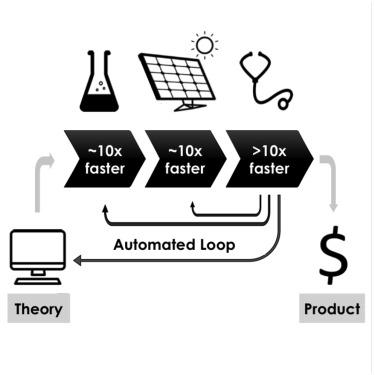Joule ( IF 39.8 ) Pub Date : 2018-06-12 , DOI: 10.1016/j.joule.2018.05.009 Juan-Pablo Correa-Baena , Kedar Hippalgaonkar , Jeroen van Duren , Shaffiq Jaffer , Vijay R. Chandrasekhar , Vladan Stevanovic , Cyrus Wadia , Supratik Guha , Tonio Buonassisi

|
Successful materials innovations can transform society. However, materials research often involves long timelines and low success probabilities, dissuading investors who have expectations of shorter times from bench to business. A combination of emergent technologies could accelerate the pace of novel materials development by ten times or more, aligning the timelines of stakeholders (investors and researchers), markets, and the environment, while increasing return on investment. First, tool automation enables rapid experimental testing of candidate materials. Second, high-performance computing concentrates experimental bandwidth on promising compounds by predicting and inferring bulk, interface, and defect-related properties. Third, machine learning connects the former two, where experimental outputs automatically refine theory and help define next experiments. We describe state-of-the-art attempts to realize this vision and identify resource gaps. We posit that over the coming decade, this combination of tools will transform the way we perform materials research, with considerable first-mover advantages at stake.
中文翻译:

通过自动化,机器学习和高性能计算加速材料开发
成功的材料创新可以改变社会。但是,材料研究通常涉及较长的时间和较低的成功概率,这使那些期望从工作台到业务的较短时间的投资者望而却步。新兴技术的组合可以使新型材料的开发速度提高十倍甚至更多倍,使利益相关者(投资人和研究人员),市场和环境的时间表保持一致,同时提高投资回报率。首先,工具自动化可以对候选材料进行快速的实验测试。其次,高性能计算通过预测和推断体积,界面以及与缺陷相关的特性,将实验带宽集中在有前途的化合物上。第三,机器学习将前两者联系起来,实验输出会自动完善理论并帮助定义下一个实验。我们描述了实现这一愿景并确定资源缺口的最新尝试。我们认为,在未来十年中,这些工具的组合将改变我们进行材料研究的方式,并具有相当大的先发优势。



























 京公网安备 11010802027423号
京公网安备 11010802027423号